This set of Enzyme Technology MCQs focuses on “Methods of Immobilization – 2”.
1. Which of the following is a disadvantage of immobilized enzymes over free enzymes?
a) Repeated use of enzymes
b) Minimal downstream processing
c) Enzyme may become inactive
d) Thermal stability of the enzyme increases
View Answer
Explanation: The disadvantage of immobilized enzymes over free enzymes is that they may become inactive. The following are the advantages:
• Repeated use of enzymes as it can be easily separated from the mixture.
• Enzyme immobilization prevents the enzyme from contaminating the product and in turn minimizing downstream processing cost.
• Thermal stability of the enzyme increases.
2. The surface of the matrix on which an enzyme is immobilized is called __________
a) enzyme immobilization
b) adsorption
c) biosensor
d) carrier matrix
View Answer
Explanation: The surface on the matrix on which an enzyme is immobilized is referred to as the carrier matrix. Enzyme immobilization means confining an enzyme to a confined space. Biosensor is an analytical device which convert biological response into an electrical signal. The enzyme is bound to a suitable adsorbent, thus rendering the enzyme immobile. This method is called adsorption.
3. Pick the odd one out.
a) Inertness of the carrier matrix
b) Matrix should be cheap
c) Repeated use of enzymes
d) Matrix should not allow microbial contamination
View Answer
Explanation: The properties of the carrier matrix are as follows:
• Inertness of the matrix.
• Matrix should be cheap.
• Matrix should not allow microbial contamination.
• Matrix should render enzyme immobile.
• Matrix stability.
• Matrix physical strength.
• Matrix should be easily available.
Repeated use of enzymes is an advantage of immobilized enzymes. Enzyme immobilization means confining an enzyme to a confined space.
4. Which of the following is not an example of adsorbent?
a) Clay
b) Sepharose
c) Porous carbon
d) Ion-exchange matrices
View Answer
Explanation: The method in which the enzyme is bound to suitable adsorbent material rendering it immobile is called adsorption and the matrix used is called adsorbents. Examples of suitable adsorbents are porous carbon, clays, hydrous metal oxides, glasses and polymeric aromatic resins, ion-exchange matrices etc. Sepharose is the matrix used in immobilization by covalent binding.
5. The immobilization method in which the enzyme is linked to the carrier matrix by covalent bond between them is referred to as __________
a) adsorption
b) covalent binding
c) entrapment
d) membrane confinement
View Answer
Explanation: In the immobilization method by covalent binding, the enzyme is linked to the carrier matrix by covalent bond between them. This method allows strong binding with little or no leakage of enzyme. This method allows less enzyme loading capacity. Adsorption method of immobilization involves binding of enzyme to suitable adsorbent which renders it immobile. The entrapment method of immobilization involves the entrapment of enzyme within suitable gel or fibers. Immobilization by membrane confinement involves confining the enzyme in aqueous solution within a semipermeable membrane.
6. In which type of immobilization, the enzyme will be in a molecular cage?
a) Adsorption
b) Covalent binding
c) Entrapment
d) Membrane confinement
View Answer
Explanation: Entrapment is a method in which the enzyme is entrapped within suitable gel or fiber with the covalent bond being formed or not between the enzyme molecule and the matrix. As a result of non-covalent binding, the enzyme will be in molecular cage. This process is known as physical caging. The loading capacity of enzyme in this case is 1g/g gel or fiber. Adsorption method of immobilization involves binding of enzyme to suitable adsorbent which renders it immobile. Immobilization by membrane confinement involves confining the enzyme in aqueous solution within a semipermeable membrane. Covalent binding refers to the method in which the enzyme is linked to the carrier matrix by covalent bond between them.
7. In which of the following method, entrapment can be achieved?
a) Adsorption
b) Membrane confinement
c) Covalent binding
d) Microencapsulation
View Answer
Explanation: Entrapment can be achieved by using microencapsulation. In this method entrapment, the enzyme is entrapped within a semipermeable membrane of a microcapsule and this is done by interfacial polymerization. In immobilization by adsorption, the enzyme is bound to suitable adsorbent which renders it immobile. In membrane confinement, the enzyme in aqueous solution is confined within a semipermeable membrane. In covalent binding, the enzyme is linked to the carrier matrix by covalent bond between them.
8. In ________ method, the enzyme molecule in aqueous solution is confined within a semipermeable membrane.
a) adsorption
b) covalent binding
c) entrapment
d) membrane confinement
View Answer
Explanation: In membrane confinement method, the enzyme molecule in aqueous solution within a semipermeable membrane which allows free movement of substrates and products to enter and exit the membrane, but not allowing the enzyme to leave its space. This can be achieved by using hollow fiber or placing a semipermeable membrane in vessel such that 2 chambers are formed with one containing enzyme and other the substrate.
9. What does the following diagram represent?
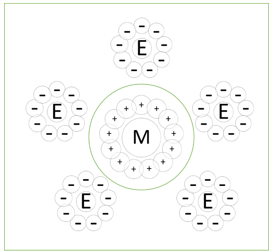
a) Covalent binding
b) Adsorption
c) Entrapment
d) Membrane confinement
View Answer
Explanation: The above diagram represents the immobilization of enzyme by adsorption. In this method, the enzyme is bound to a suitable adsorbent material, thus rendering the enzyme immobile. The interactions majorly involve weak vanderwaals interactions, H-bond or ionic type interactions. Examples of adsorbent used are porous carbon, clay, ion-exchange matrix etc.
10. What does the following diagram represent?
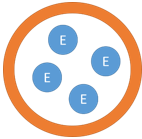
a) Covalent binding
b) Adsorption
c) Entrapment
d) Membrane confinement
View Answer
Explanation: The above diagram represents the immobilization by membrane confinement. In this method, enzyme in aqueous solution is confined with a semipermeable membrane. The diagram of adsorption is represented by,
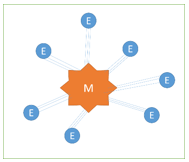
The diagram of adsorption is represented by,
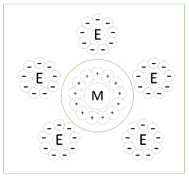
The diagram of entrapment is represented by,
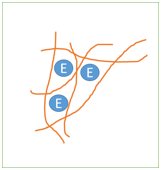
Sanfoundry Global Education & Learning Series – Enzyme Technology.
To practice MCQs on all areas of Enzyme Technology, here is complete set of 1000+ Multiple Choice Questions and Answers.
If you find a mistake in question / option / answer, kindly take a screenshot and email to [email protected]
- Practice Biotechnology MCQs
- Apply for Chemical Engineering Internship
- Apply for Biotechnology Internship
- Check Chemical Engineering Books
- Check Enzyme Technology Books
